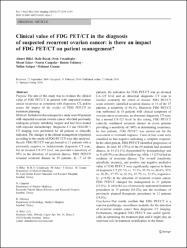Clinical value of FDG PET/CT in the diagnosis of suspected recurrent ovarian cancer: is there an impact of FDG PET/CT on patient management?

Göster/
Erişim
info:eu-repo/semantics/embargoedAccessTarih
2010Yazar
Bilici, Ahmet ErkanÖven Ustaalioğlu, Bala Başak
Şeker, Mesut
Aslan Canpolat, Nesrin
Tekinsoy, Bülent
Salepçi, Taflan
Gümüş, Mahmut
Üst veri
Tüm öğe kaydını gösterKünye
Bilici, A. E., Öven Ustaalioğlu, B. B., Şeker, M., Aslan Canpolat, N., Tekinsoy, B., Salepçi, T. ve Gümüş, M. (2010). Clinical value of FDG PET/CT in the diagnosis of suspected recurrent ovarian cancer: is there an impact of FDG PET/CT on patient management? European Journal of Nuclear Medicine and Molecular Imaging, 37(7), 1259-1269. https://dx.doi.org/10.1007/s00259-010-1416-2Özet
The aim of this study was to evaluate the clinical value of FDG PET/CT in patients with suspected ovarian cancer recurrence as compared with diagnostic CT, and to assess the impact of the results of FDG PET/CT on treatment planning.Included in this retrospective study were 60 patients with suspected recurrent ovarian cancer who had previously undergone primary debulking surgery and had been treated with adjuvant chemotherapy. Diagnostic CT and FDG PET/CT imaging were performed for all patients as clinically indicated. The changes in the clinical management of patients according to the results of FDG PET/CT were also analysed.FDG PET/CT was performed in 21 patients with a previously negative or indeterminate diagnostic CT scan, but an elevated CA-125 level, and provided a sensitivity of 95% in the detection of recurrent disease. FDG PET/CT revealed recurrent disease in 19 patients. In 17 of 60 patients, the indication for FDG PET/CT was an elevated CA-125 level and an abnormal diagnostic CT scan to localize accurately the extent of disease. FDG PET/CT scans correctly identified recurrent disease in 16 of the 17 patients, a sensitivity of 94.1%. Moreover, FDG PET/CT was performed in 18 patients with clinical symptoms of ovarian cancer recurrence, an abnormal diagnostic CT scan, but a normal CA-125 level. In this setting, FDG PET/CT correctly confirmed recurrent disease in seven patients providing a sensitivity of 100% in determining recurrence. In four patients, FDG PET/CT was carried out for the assessment of treatment response. Three of four scans were classified as true-negative indicating a complete response. In the other patient, FDG PET/CT identified progression of disease. In total, 45 (75%) of the 60 patients had recurrent disease, in 14 (31.1%) documented by histopathology and in 31 (68.9%) on clinical follow-up, while 15 (25%) had no evidence of recurrent disease. The overall sensitivity, specificity, accuracy, and positive and negative predictive value of FDG PET/CT were significantly superior to those of diagnostic CT (95.5% vs. 55.5%, 93.3% vs. 66.6%, 95% vs. 58.3%, 97.7% vs. 83.3%, 87.7% vs. 33.3%, respectively; p = 0.02) in the detection of recurrent ovarian cancer. FDG PET/CT changed the management in 31 patients (51.6%). It led to the use of previously unplanned treatment procedures in 19 patients (61.2%) and the avoidance of previously planned therapeutic procedures in 12 patients (38.8%).Our results confirm that FDG PET/CT is a superior posttherapy surveillance modality for the detection of recurrent ovarian cancer than diagnostic CT imaging. Furthermore, integrated FDG PET/CT was useful specifically in optimizing the treatment plan and it might play an important role in treatment stratification in the future.
WoS Q Kategorisi
Q1Scopus Q Kategorisi
Q1Kaynak
European Journal of Nuclear Medicine and Molecular ImagingCilt
37Sayı
7Koleksiyonlar
- Makale Koleksiyonu [3777]
- PubMed İndeksli Yayınlar Koleksiyonu [4230]
- Scopus İndeksli Yayınlar Koleksiyonu [6574]
- WoS İndeksli Yayınlar Koleksiyonu [6631]

















